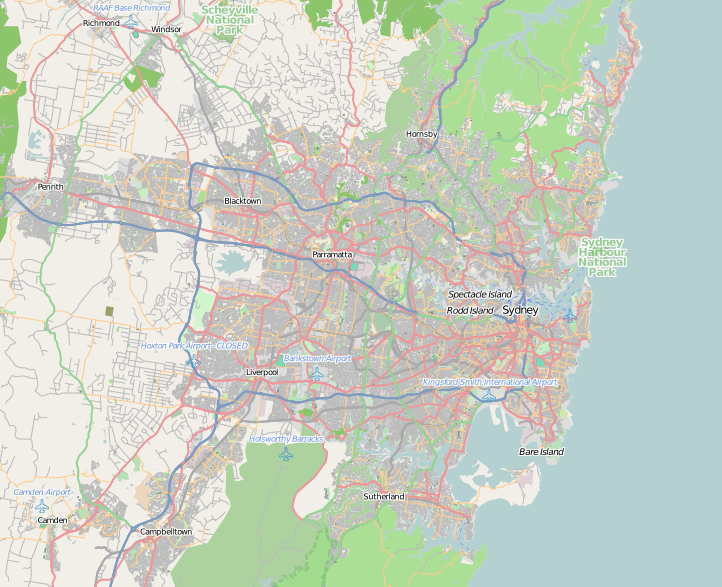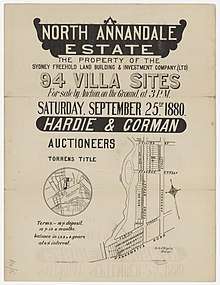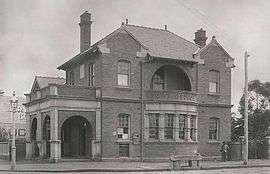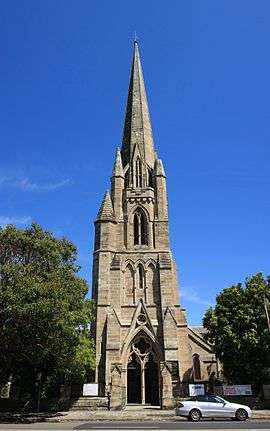Annandale, New South Wales
Annandale is a suburb in the Inner West[2] of Sydney, in the state of New South Wales, Australia. Annandale is located within 5 kilometres west of the Sydney central business district and is part of the local government area of the Inner West Council.[3] Annandale's northern end lies on Rozelle Bay, which is on Sydney Harbour. Glebe lies to its east, Lilyfield and Leichhardt to its west and Stanmore and Camperdown to its south.
| Annandale Sydney, New South Wales | |||||||||||||||
|---|---|---|---|---|---|---|---|---|---|---|---|---|---|---|---|
 Former tram service, corner of Booth and Johnston Streets 1955 | |||||||||||||||
 Annandale Location in the Sydney metropolitan area | |||||||||||||||
| Coordinates | 33.881°S 151.171°E | ||||||||||||||
| Population | 9,451 (2016 census)[1] | ||||||||||||||
| Established | 1823 | ||||||||||||||
| Postcode(s) | 2038 | ||||||||||||||
| Location | 5 km (3 mi) west of Sydney CBD | ||||||||||||||
| LGA(s) | Inner West Council | ||||||||||||||
| State electorate(s) | Balmain | ||||||||||||||
| Federal Division(s) | |||||||||||||||
| |||||||||||||||
History
Major George Johnston (1764–1823) arrived on the First Fleet ship Lady Penrhyn, which brought convicts to Australia from England. He was granted 600 acres (2.4 km2) of land in the area around Annandale and Stanmore, which became known as Johnston's Bush. He later renamed it Annandale after his birthplace Annan in Scotland, United Kingdom. His name is remembered in Johnston Street, Johnston Lane, Johnstons Creek and Johnstons Bay.[4] Johnston and his wife Esther Abrahams, one of the convicts on the Lady Penrhyn, farmed the property with their children. They built a fine residence called Annandale House in 1799, some distance back from Parramatta Road. It was demolished in 1905, although the original gates were preserved and rebuilt on the grounds of Annandale Public school nearby on Johnston Street. George's son Robert inherited the estate, but in 1877 sold it to John Young, who was a businessman, architect and mayor.
Young began turning the Johnston estate into an attractive suburb by building a number of picturesque houses. One of those houses was Kenilworth, with a "witch's cap" style of roof common to that period of architecture, which Young rented to Henry Parkes, father of Federation and former Premier of NSW. Kenilworth was sold for $3.35 million in 2007.[5] Other houses in the group were The Abbey, Oybin, Rozelle (now demolished), Greba, Hockingdon, Highroyd and Claremont (now demolished).[6] Some of the houses are popularly known as "witches houses" because their towers resemble witches' hats. Highroyd was given a major restoration which took twenty years and was completed in 2009. The restoration was supervised by heritage architect David Springett and Highroyd was nominated for the heritage category of the Australian Institute of Architects New South Wales awards in 2009.[7]
The Abbey

Of the various houses in this group, The Abbey is the most notable. Built by John Young, The Abbey has been described as a stone Gothic Revival mansion, modelled on Scottish manors. Young gave his imagination a free rein and the house incorporates gables, arches, gargoyles, lions, quatrefoils, chimneys, turrets, a cloister and a tower with copper cladding (it was rumoured that Young may have stolen gargoyles from St Mary's Cathedral, which he built, but there was no proof). Young was the highest ranking Mason in Australia and The Abbey incorporates Masonic themes. It is possible that the building may have been used by Young as a Masonic Lodge. After Young's death, The Abbey was occupied by a series of tenants, who subdivided the house to create flats and flatettes.
A new owner acquired the house in 1959 and restored it. It was listed on the (now defunct) Register of the National Estate.[8] The house was sold for A$4.86 million on 7 November 2009, setting a record residential price for the Annandale area. The selling agent had been hoping for a price of A$5 million, but despite a crowd of 200 people attending the on-site auction, there were only two bidders. The auction itself took nearly an hour to complete, as one bidder regularly engaged in disputes with the auctioneer over the conduct of the auction.[5]
Other developments
Another home in the area was Kentville, which was built as John Young's home, in a three hectares (seven acres) garden setting adjacent to Rozelle Bay. The land was bought by Young in 1877, and included a cottage built by Robert Johnston. Young enlarged the cottage and named it Kentville after his home county in the UK. He also built a bowling green on the land and opened it to the public.

Young hoped that the Annandale area would be fine enough to rival places like Darling Point, but was unable to prevent the growth of industries or the subdivision of lots. He died in 1907. The land was subdivided in the late part of the 19th century and more so after Young's death. Since then it has undergone a number of social transformations, from factory floors, migrant stop off, ageing population, to now young families and modern small and micro businesses.
Young was an alderman on the Leichhardt Borough Council from 1879, and mayor that year and in 1884-85. Returning in 1891 from travels in Europe and Asia, Young led a secession movement resulting in the incorporation of the Annandale Borough Council.[9] The Municipality of Annandale was incorporated on 2 January 1894 and merged into the Municipality of Leichhardt in 1949. The Annandale Council Chambers are now the home of the Annandale Neighbourhood Centre.[10]
Johnston Street is also notable for being the first 30-metre-wide (98 ft) street in Sydney.
Heritage


Annandale has a number of heritage-listed sites, including:
- Johnston Street: Hunter Baillie Memorial Presbyterian Church[11]
- 2-12 Johnston Street: Goodman's Buildings[12]
- 182 Johnston Street: Substation No. 15[13]
- off Taylor Street, Hogan Park: Johnston's Creek Sewer Aqueduct[14]
- Booth Street: Sewage Pumping Station 3[15]
Other significant historic buildings include:
- Annandale Council Chambers, 79 Johnston Street, constructed in 1899.
- Annandale North Public School, Johnston Street
- Annandale Post Office, Johnston Street, an example of the Federation Free Classical style.[16][17]
- Annandale Public School, Johnston Street
- North's Factory, 43 Trafalgar Street, the former Beale Piano Factory,[18] the first and largest Australian piano manufacturer.
- The Abbey and stone walls, Johnston Street
- Uniting Church (former Methodist Church), 81A Johnston Street
- Victorian semi-detached villas, 13-15 Collins Street
- Hillcrest, a freestanding Victorian home on the Northern end Nelson St
The Annandale Heritage Festival takes place each year during Australian Heritage Week in April.
Demographics
According to the 2016 census, there were 9,451 people living in Annandale. 66.3% of them were born in Australia. The next most common countries of birth were England 5.2%, New Zealand 2.5%, United States of America 1.3% and China 1.2%. 77.5% of people only spoke English at home. Other languages spoken at home included Italian 1.9%, Mandarin 1.6%, Spanish 1.2%, Greek 1.2% and Cantonese 1.1%. The most common responses for religious affiliation were No Religion 44.7%, Catholic 20.8%, Not stated 11.3%, Anglican 9.5% and Eastern Orthodox 2.3%.[1]
Schools
- Annandale Public School at 25-31 Johnston Street and Annandale North Public School at 206 Johnston Street are both on the Register of the National Estate.[8]
- St Brendan's Catholic School is at 34 Collins Street.
Churches

- Village Church, Annandale (Anglican), Johnston Street[19]
- Hunter Baillie Memorial Presbyterian Church, Johnston Street[11]
- St Brendan's Catholic Church, Johnston Street[20]
- Annandale Uniting Church, Johnston Street[21]
Culture
Environment
Annandale is bound by Johnston Creek in the east and White's Creek in the West, and Sydney Harbour to the North.
Eco-Annandale Exhibition
The Eco-Annandale exhibition has been run annually since 2009. Each year, the group exhibition focuses on an aspect of Ecological Sustainability.[22]
Footprints EcoFestival
The Footprints EcoFestival is also run annually, in White's Creek Valley. The first year it was run at World Environment Day, however a storm caused its relocation to the Leichhardt Town Hall. The festival is now held in August.[23]
Sport
- A Rugby League team representing the suburb played in the NSWRL Premiership competition between 1910-1920.
- Amy Hudson, an allrounder who captained the Annandale Warratahs (Women's Cricket)[24] went on to play for Australia and Tour England.[25]
Music
- The Annandale Hotel is a popular live music venue for rock/indie bands. Live At The Annandale is an album recorded at the Annandale Hotel by American punk rock band The Bronx. Isis released a DVD of their full performance at the Annandale Hotel from 2005.
- Trafalgar Studios was where many influential bands of the 70-80s in Sydney recorded their albums at 74b Trafalgar Street. Artists who recorded here included Cold Chisel,[26] Radio Birdman, INXS, Died Pretty, Midnight Oil and Paul Kelly. Trafalgar Studios later became Electric Avenue, then home to Christian music label Emu Music. In August 2008 the property was offered for sale. Plans for demolition of the studio were put to council in June 2010 and are facing community opposition.[26]
- Australian music label Didgeridoo Records is located in Annandale.
- The band Sparkadia originated from Annandale.
- Cold Chisel guitarist Ian Moss lives in Annandale.
- Annual Hunter Baillie Spring Festival of Music was established in 1994 to raise funds for the restoration of the 1890 Hill & Son organ [27]
- Sydney's 5 Seconds of Summer pop rock band played their first gig at The Annandale Hotel.
Pop culture
- American author, Mark Twain, stayed in Johnston Street, in the home of Sir Henry Parkes toward the end of Parkes' life, according to Bill Bryson in his Down Under book.
- Booth Street, one of the main streets of the suburb, is a song by popular local band Youth Group on their debut album Urban and Eastern (2000).
- Sydney band Seventeen (featuring members of Smudge and 2 Litre Dolby) have a song called Annandale on their 1999 album Gaggin For It.
Transport
Buses are the primary mode of public transport in Annandale. The major bus corridor is along Booth St, through the middle of the suburb. This corridor is served by the 470 (operating between Lilyfield and the city) and the 370 (between Leichhardt and Coogee via St Peters). A large number of bus routes (413, 436, 438, L38, 439, L39, 440, 461, 480, 483 and M10) operate along Parramatta Rd at the southern border of the suburb. These all service the city, with the M10 continuing to Maroubra Junction. In the north east of the suburb, the 433 operates along The Crescent between the city and Balmain.[28]
The Rozelle Bay stop on the Dulwich Hill Line of Sydney's light rail network is located in the north of the suburb, the Jubilee Park stop is also accessible from Annandale. Trams operate to east to Central railway station via Pyrmont, and south-west to Dulwich Hill.
Notable residents
- Sid Barnes, a cricketer[29]
- Claudia Chan Shaw, born in Annandale, fashion designer
- Fred Cress, painter – had a studio in Annandale
- Ross Edwards, composer[30]
- Dick Ellis, a soldier and intelligence officer[31]
- Bert Felan, a public relations officer[32]
- Ezzie Fenton, a journalist[33]
- Isabel Flick, Aboriginal rights activist
- Thelma Forshaw, writer, journalist – grew up in Annandale
- Belle Golding, feminist, suffragist and labor activist
- Douglas Grant, Australian Aboriginal draftsman, soldier, POW and raconteur
- Amy Hudson, Cricketer (see above)
- Kim Moyes, member of The Presets - has a studio in Annandale
- Robert Johnston - Naval Officer
- Henry Parkes, 'Father of Federation' and Premier of NSW died in Annandale
- Barbara Ramsden, book editor at Melbourne University Press
- Craig Reucassel, comedian and member of The Chaser
- Abe Saffron, nightclub owner and property developer was born in Annandale
- John Stanley, 2UE Broadcaster
- Allen Taylor, Mayor of Annandale, Lord Mayor of Sydney, MLC, Timber & Shipping Merchant
- Eric Wilson, Australian painter[34]
- John Young, businessman, architect, builder and mayor
References
- Australian Bureau of Statistics (27 June 2017). "Annandale (State Suburb)". 2016 Census QuickStats. Retrieved 20 January 2018.

- Australian Suburb Guide: Sydney Inner West Archived 26 December 2012 at the Wayback Machine Retrieved 7 August 2013.
- Gregory's Sydney Street Directory, Gregory's Publishing Company, 2007
- Pollon, Frances, ed. (1990). Book of Sydney Suburbs. Angus and Robertson.
- Sun-Herald, 8 November 2009, p.3
- Annandale – the houses of John Young Leichhardt Council
- Sunday Telegraph, 24 May 2009, p.68
- The Heritage of Australia, p. 2/34
- Australian Dictionary of Biography - Young, John (1827 - 1907)
- Annandale Community Centre Annandale on the Web
- "Hunter Baillie Memorial Presbyterian Church". New South Wales State Heritage Register. Office of Environment and Heritage. H00011. Retrieved 18 May 2018.
- "Goodman's Buildings". New South Wales State Heritage Register. Office of Environment and Heritage. H00672. Retrieved 18 May 2018.
- "Substation". New South Wales State Heritage Register. Office of Environment and Heritage. H00941. Retrieved 18 May 2018.
- "Johnston's Creek Sewer Aqueduct". New South Wales State Heritage Register. Office of Environment and Heritage. H01325. Retrieved 18 May 2018.
- "Sewage Pumping Station 3". New South Wales State Heritage Register. Office of Environment and Heritage. H01343. Retrieved 18 May 2018.
- "Annandale Post Office". New South Wales State Heritage Register. Office of Environment and Heritage. Retrieved 12 October 2017.
- The Heritage of Australia, Macmillan Company, 1981, p.2/34
- Beale pianos history
- Village Church
- St Brendan (1898) - Annandale Our Parishes
- "Annandale Uniting Church". Uniting Church in Australia.
- Eco-Annandale 2014 Catalog
- Footprints EcoFestival, White's Creek Valley Annandale
- Annandale Warratahs
- Amy Hudson, inducted into Hall of Fame
- An Anecdotal History of Annandale: 74B Trafalgar St Recording Studios, Ramin Communications, 15 June 2010 Annandale on the Web.
- 2011 Hunter Baillie Spring Festival of Music Local Notes
- Sydney Inner West/South Guide Transit Systems
- "Barnes, Sidney George (Sid) (1916-1973)". Australian Dictionary of Biography. Melbourne University Press. ISSN 1833-7538 – via National Centre of Biography, Australian National University.
- "Ross Edwards and his Fifth Symphony". The Australian. Retrieved 29 March 2020.
- "Ellis, Charles Howard (Dick) (1895-1975)". Australian Dictionary of Biography. Melbourne University Press. ISSN 1833-7538 – via National Centre of Biography, Australian National University.
- "Felan, Albert John (Bert) (1919-1968)". Australian Dictionary of Biography. Melbourne University Press. ISSN 1833-7538 – via National Centre of Biography, Australian National University.
- "Fenston, Emse (Ezzie) (1908-1972)". Australian Dictionary of Biography. Melbourne University Press. ISSN 1833-7538 – via National Centre of Biography, Australian National University.
- "Eric WILSON". Collection Online. National Gallery of Victoria. Retrieved 9 August 2015.
External links
| Wikimedia Commons has media related to Annandale, New South Wales. |
- Roberts, Alan (2008). "Annandale". Dictionary of Sydney. Retrieved 24 September 2015. [CC-By-SA]